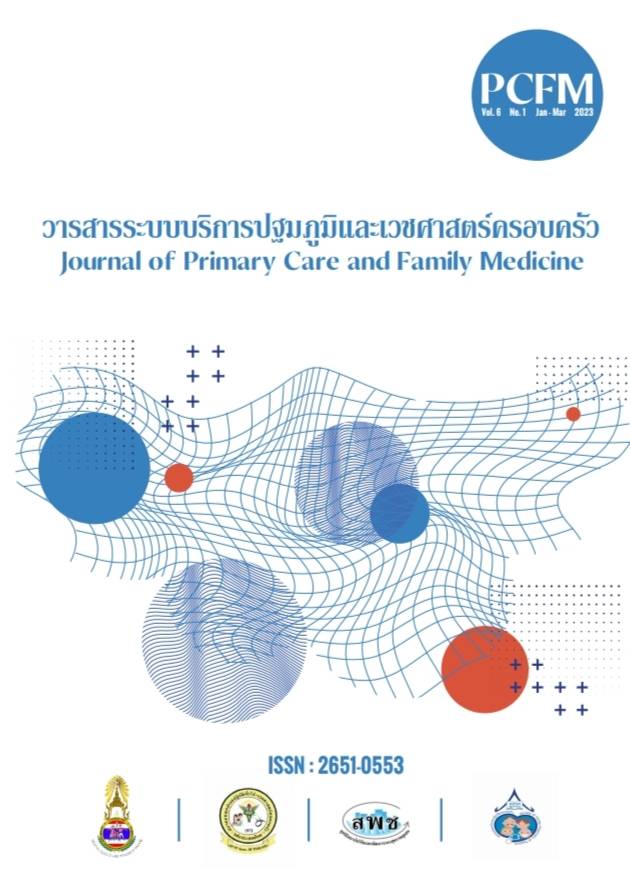ผลลัพธ์ของการดูแลผู้ป่วยแบบประคับประคอง โดยแพทย์เวชศาสตร์ครอบครัว โรงพยาบาลจอมทอง
Main Article Content
บทคัดย่อ
ความเป็นมา: โรงพยาบาลจอมทองได้เริ่มพัฒนาระบบการดูแลผู้ป่วยแบบประคับประคองโดยแพทย์เวชศาสตร์ครอบครัว แต่ยังไม่เคยมีการประเมินผลลัพธ์ ผู้วิจัยจึงสนใจศึกษาเรื่องนี้เพื่อนำไปใช้ในการพัฒนาระบบการดูแลผู้ป่วยแบบประคับประคองให้ดียิ่งขึ้น
วัตถุประสงค์: เพื่อเปรียบเทียบผลลัพธ์ของการดูแลผู้ป่วยแบบประคับประคองโดยมีแพทย์เวชศาสตร์ครอบครัวร่วมดูแลกับกลุ่มผู้ป่วยที่ดูแลโดยแพทย์สาขาอื่น
วิธีวิจัย ารศึกษาแบบย้อนหลัง เกี่ยวกับผลลัพธ์การดูแลผู้ป่วยแบบประคับประคอง ที่เข้ารักษาที่โรงพยาบาลระหว่างวันที่ 1 มิถุนายน พ.ศ. 2563 ถึง 31 พฤษภาคม พ.ศ. 2564 จำนวน 284 คน โดย รวบรวมข้อมูลจากเวชระเบียน วิเคราะห์ข้อมูลพื้นฐานโดยใช้ความถี่ ร้อยละ ส่วนเบี่ยงเบนมาตรฐานและเปรียบเทียบผลลัพธ์ของการดูแลผู้ป่วยโดยแพทย์ 2 กลุ่มด้วยการทดสอบไคสแควร์ และการทดสอบที
ผลการศึกษา: ผู้ป่วยแบบประคับประคองที่มีแพทย์เวชศาสตร์ครอบครัวร่วมดูแล จำนวน 169 คน (ร้อยละ 60) มีผลลัพธ์ของการดูแล ดังนี้ การจัดประชุมระหว่างทีมแพทย์และครอบครัวผู้ป่วย ร้อยละ 80 ( p < 0.001) การวางแผนการดูแลตนเองล่วงหน้า ร้อยละ 91 (p < 0.001) ไม่ใส่ท่อช่วยหายใจ ร้อยละ 99 (p < 0.001) ได้รับยาบรรเทาอาการ ร้อยละ 60 (p < 0.001) ได้ส่งต่อข้อมูลในชุมชนและเยี่ยมบ้าน ร้อยละ 70 (p < 0.001) ไม่กลับมารักษาซ้ำ ร้อยละ 99 (p = 0.010) ไม่กลับมานอนโรงพยาบาลซ้ำ ร้อยละ 99 (p = 0.157) และความพึงพอใจในการบริการ มีคะแนนเฉลี่ย 47 จากคะแนนเต็ม 50 (SD 2.66) (p < 0.001)
สรุป: ผู้ป่วยที่มีแพทย์เวชศาสตร์ครอบครัวร่วมดูแล มีกระบวนการและผลลัพธ์การดูแลดีกว่าแพทย์สาขาอื่น ดังนั้น การพัฒนาแนวทางการดูแลอย่างเป็นระบบ และสนับสนุนให้แพทย์สาขาอื่นมีความรู้ความเข้าใจ การดูแลแบบประคับประคอง จะช่วยให้ผลลัพธ์การดูแลดีขึ้น
Article Details

อนุญาตภายใต้เงื่อนไข Creative Commons Attribution-NonCommercial-NoDerivatives 4.0 International License.
เนื้อหาและข้อมูลในบทความที่ลงตีพิมพ์ในวารสาร PCFM ถือเป็นข้อคิดเห็นและความรับผิดชอบของผู้เขียนบทความโดยตรง ซึ่งกองบรรณาธิการวารสารไม่จำเป็นต้องเห็นด้วยหรือร่วมรับผิดชอบใด ๆ
บทความ ข้อมูล เนื้อหา รูปภาพ ฯลฯ ที่ได้รับการตีพิมพ์ลงในวารสาร PCFM ถือเป็นลิขสิทธิ์ของวารสาร PCFM หากบุคคลหรือหน่วยงานใดต้องการนำทั้งหมดหรือส่วนหนึ่งส่วนใดไปเผยแพร่ต่อหรือเพื่อกระทำการใด ๆ จะต้องได้รับอนุญาตเป็นลายลักษณ์อักษรจากวารสาร PCFM ก่อนเท่านั้น
เอกสารอ้างอิง
กลุ่มข้อมูลข่าวสารสุขภาพ. สถิติสาธารณสุข พ.ศ. 2562. นนทบุรี: กองยุทธศาสตร์และแผนงาน กระทรวงสาธารณสุข; 2562
Cardona-Morrell M, Kim J, Turner RM, Anstey M, Mitchell IA, Hillman K. Non-beneficial treatments in hospital at the end of life: a systematic review on extent of the problem. Int J Qual Health Care. 2016;28(4):456-69.
World Health Organization. Palliative care [Internet]. 2020 [cited 11 february 2022]. Available from: https://www.who.int/news-room/fact-sheets/detail/palliative-care
National Comprehensive Cancer Network. NCCN Guidelines for supportive care:
palliative care [internet]. 2018 [cited 10 Jan 2022]. Available from : https://www.nccn. org/professionals/physician_gls/default.aspx#supportive.
Chiang JK, Kao YH. Quality of end-of-life care of home-based care with or without palliative services for patients with advanced illnesses. Medicine (Baltimore). 2021;100(18):1-7.
Cassel B. GM, May P.,Del fabbro E., Noreika D. Impact of specialist palliative care on re-admission: A " competing risk" analysis to take mortality into account Journal of Pain and Symptom Managemet 2018;55(2):581.
Hua M, Lu Y, Ma X, Morrison RS, Li G, Wunsch H. Association Between the Implementation of Hospital-Based Palliative Care and Use of Intensive Care During Terminal Hospitalizations. JAMA 2020;3(1):e1918675.
Elnadry J. Home-Based Palliative Care Reduces Hospital Reamissions Journal of Pain and Symptom Managemet. 2017;53(2):428 - 9.
Hughes MT, Smith TJ. The growth of palliative care in the United States. Annu Rev Public Health. 2014;35:459-75.
Wayne W. Daniel CLC. Biostatistics: A foundation for anlysis in the health sciences 10th ed. United States of America; 2013
Chetta Ngamjarus VC, Edward McNeil. n4Studies: Sample Size Calculation for an Epidemiological Study on a Smart Device. Siriraj Med J. 2016;68:160-70.
Neesanun S. Non-Beneficial Treatments in Hospitalized Advance Stage Cancer Patients. Region 3 Medical and Public Health Journal 2019;16:1-10
Brighton LJ, Bristowe K. Communication in palliative care: talking about the end of life, before the end of life. Postgrad Med J. 2016;92(1090):466-70.
ราชวิทยาลัยแพทย์เวชศาสตร์ครอบครัวแห่งประเทศไทย. หลักสูตรและเกณฑ์การฝึกอบรมแพทย์ประจำบ้าน เพื่อวุฒิบัตรแสดงความรู้ ความชำนาญ ในการประกอบวิชาชีพเวชกรรม สาขาเวชศาสตร์ครอบครัว 2561 [อินเทอร์เน็ต]. 2561 [เข้าถึงเมื่อ 11 ก.พ. 2565] เข้าถึงได้จาก: https://thaifammed.org/training/page-05
Karen Hancock JMC, Sharon M Parker,Phyllis N Butow, Sue Carrick,David Currow, et al. Truth-telling in discussing prognosis in advanced life-limiting illnesses: a systematic review. Palliative Medicine. 2007;21:507–17.
Bradley NM, Sinclair E, Danjoux C, et al. The do-not-resuscitate order: incidence of documentation in the medical records of cancer patients referred for palliative radiotherapy. Curr Oncol. 2006;13(2):47-54
Piili RP, Lehto JT, Luukkaala T, Hinkka H, Kellokumpu-Lehtinen PI. Does special education in palliative medicine make a difference in end-of-life decision-making. BMC Palliat Care. 2018;17(1):94.
ปฐมพร ศิรประภาศิริ,บรรณาธิการ. คู่มือการดูแลผู้ป่วยแบบประคับประคองและระยะท้าย (สำหรับบุคลากรทางการแพทย์). นนทบุรี:กรมการแพทย์ กระทรวงสาธารณสุข; 2563.
Abdi D. Osman MAR, Louisa Lam, Chien Che Lin, Michael Yeoh, Simon Judkins, Neely Pratten. Cardiopulmonary resuscitation and endotracheal intubation decisions for adults with advance care direction and resuscitation plans in the emergency department. Australasian Emergency Caer 2020;23(4):247 - 51.
สำนักงานปลัดกระทรวงสาธารณสุข. แนวทางการดำเนินงาน คลินิกหมอครอบครัว สำหรับหน่วยบริการ.นนทบุรี: สำนักบริหารการสาธารณสุข สำนักงานปลัดกระทรวงสาธารณสุข; 2559
Catherine Hudon M-CC, Fatoumata Diadion, Mireille Lambert. Danielle Bouliane. Case Management in Palliative Care for Frequent Users of health Care Services With Chronic Diseases: A Qualitation Study of Patient and Family Experience Ann Fam Med. 2015(13):523 -8.
Detsyk OZ BO, Babich PM. Quality of life of patients receiving home-based palliative care from family physicians and mobile palliative care team. Wiad Lek. 2020(73(8)):1681-9.
Dzierzanowski T, Kozlowski M. Opioid prescribing attitudes of palliative care physicians versus other specialists: a questionnaire-based survey. Postgrad Med J. 2022;98(1156):119-23.
Shofield G. Palliative opioid use, palliative sedation and euthanasia: reaffirming the distinction. J Med Ehtics. January 2020;46(1):48 - 50.
Dowell D, Haegerich TM, Chou R. CDC Guideline for Prescribing Opioids for Chronic Pain--United States, 2016. JAMA. 2016;315(15):1624-45.
Lau J, Mazzotta P, Whelan C, et al. Opioid safety recommendations in adult palliative medicine: a North American Delphi expert consensus. BMJ Support Palliat Care. 2022;12(1):81-90.
Preuss CV, Kalava A, King KC. Prescription of Controlled Substances: Benefits and Risks. In: StatPearls. Treasure Island (FL): StatPearls Publishing; March 13, 2022.
Colleen Webber RV, Christine Knott, Yingwei Peng and Patti A. Groome. Community Palliative Care Initiatives to Reduce End- of-life Hospital Utilization and In-Hospital Deaths: A Population-Based Observation Study Evaluation Two Home Care Intervations. Journal of Pain and Symptom Managemet. 2019;58 (2):181 - 9.
Reyniers T, Houttekier D, Pasman HR, Stichele RV, Cohen J, Deliens L. The family physician's perceived role in preventing and guiding hospital admissions at the end of life: a focus group study. Ann Fam Med. 2014;12(5):441-6.
Radka Bužgová RK, Michal Bar Satisfaction of Patients With Severe Multiple Sclerosis and Their Family Members With Palliative Care: Interventional Study. American Journal of Hospice and Palliative Medicine2021;38(11):1348-55.


